
Want to know what the classic line-up of Johnny Thunders and the Heartbreakers sounded like live? Most of us missed them the first time around and with three of them no longer with us there’s no chance whatsoever of them reforming - at least in this life.
So you’ll just have to settle for listening to “Live At The Village Gate”.
Glad you asked.
“Live At The Village Gate” is a newly-minted album on Los Angeles label Cleopatra Records. It’s out on LP and CD. It was recorded at the legendary jazz venue, The Village Gate, in New York City in 1977. Our review is here.
To many ears, it represents the ultimate recording of the infamous Heartbreakers at their highest peak. No slop, no pop. Pure power and energy that’s powerful enough to level a New York City block. It captures the notoriously drug-addled quartet in clear-eyed form and totally on their game. Out to impress and definitely Down To Kill.
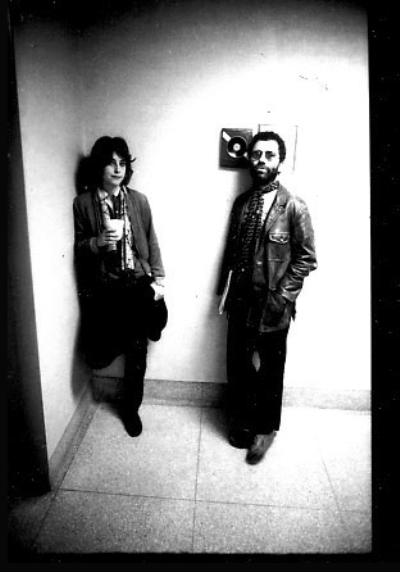 The Heartbreakers were back from a stint in London where they’d recorded their star-crossed studio album. You can read the back-story and our review here.
The Heartbreakers were back from a stint in London where they’d recorded their star-crossed studio album. You can read the back-story and our review here.
We thought it was an apt time to take the tale further and speak to someone who was there. Who better than the person who recorded it?
Brooke Delarco is a California-based music producer who was deeply immersed in the Downtown New York City music scene as a young sound engineer for the influential independent label Ork Records. Something of a path-finder in a profesison dominate by men, she did live sound for then-Ork band The Feelies.
(She's pictured at right with Ork Records' honcho Terry Ork in a photo taken by David Godlis.)
Through that connection she came to do front-of-house sound for Johnny Thunders and the Heartbreakers for their much-anticipated homecoming shows at The Village Gate. Here’s her story.
Hi Brooke. Tell us about the Village Gate and how you came to be working there wiht Johnny Thunders and the Heartbreakers. Do you remember how the Heartbreakers got to be booked into what was regarded as a jazz venue?
I was working at Vanguard Records Studio in 1976 when a friend of mine, who was mixing sound for Television and The Talking Heads, introduced me to Terry Ork who put out Television’s first record and started the booking of CBGB’s with them, Patti Smith and all the others. He was managing the Feelies by then. I had done some demos with a band that were friends of the Feelies. They really liked the sound I got so they hired me to do a single with Ork, and then I continued on with them doing their live shows and studio recordings.
In the summer of ’77, Terry got together with Art D’Lugoff who owned the Village Gate and put on a series of shows there. Pretty much everyone except the Ramones and TV played them. Since Ork was doing all these shows there it was through him that the Heartbreakers’ booking happened as their homecoming. By then I had been working with Terry on some of his other Ork Record projects so he tapped me to help out with the sound at the Gate shows.
Were you aware of them being sick of playing either CBGB or Max’s in New York City? I guess that was motivation enough to play somewhere different.
It wasn’t so much that they were sick of playing those venues, but that Max’s and CB’s were the only places in town to play. The Gate was a much larger room and had the capacity to do better financially. The Heartbreakers played Max’s a lot since Tommy Dean, the owner, would always give them an advance and Hilly wouldn’t!
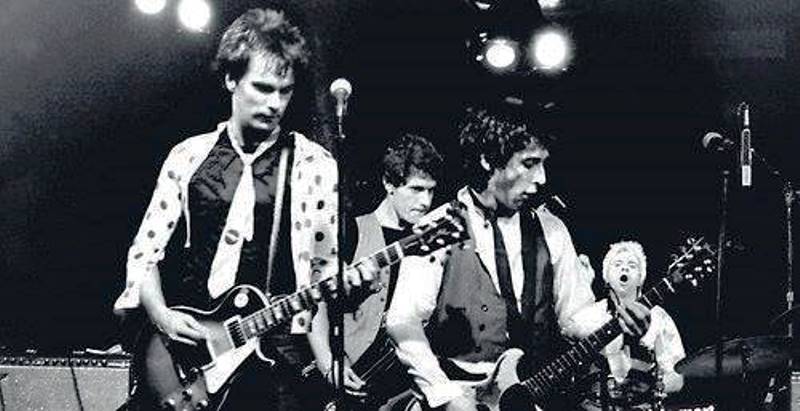
Walter, Billy, Johnny and Jerry in action at The Village Gate. Bob Gruen photo
Did the band have any trouble getting booked into The Village Gate? What would Coltrane or Miles Davis is have thought of these shows?
Again since Ork was putting on the shows he quickly jumped on the chance to have them on the run of shows.
Hard to say what Miles or Coltrane would have thought. Miles might have dug it since he was in the post “Bitches Brew” phase and was working with John Mclauglin and Tony Williams. Mclauglin and Williams had a pretty heavy jazz rock band and put out a record called “Emergency”.
How big was the room and what sort of in-house system was in place?
The room was pretty big and so was the stage. They had a really good sound system. Probably a Soundcraft 24-channel board and a tri-amped JBL speaker system with Crown amps. Sennheiser and AKG mics as well as the standard Shures.
Had you seen much of the Heartbreakers before they went to England? What was the mood around town for these homecoming shows?
I had never seen or heard them prior to this show. This was the first time I met them. Of course I had heard a lot about them and the excitement they generated. There was always a high energy buzz when the Heartbreakers played and this night was exceptional. The shows were the talk of the town and everybody on the scene turned out for them.
The band sounds very together on the release. What are your memories of how they were in the run of shows? Any truth to the story that Lee Black Childers restricted their drug intake to speed for these shows?
They were very together, having just finished recording “LAMF” and being pumped up to be back in NY and playing a three-night stand. I don’t really believe the rumor that Leee had them all doing speed. That may have been true in England but I think most of that was fueled by cocaine and I would suspect that a lot of that was charged to the record company and consumed by the production staff. Besides, once they were back in NY that would have been impossible to control.
There are some audience tapes of all three nights floating around the Internet trader sites. I’ve heard them and on the second night they slowed down considerably from the energy of the first night. So much for the staying off the junk!
I found them to be very professional in their approach to the shows. They showed up for sound checks and were very courteous to me.
Talk about the gigs and them blowing the PA on one night. Was the release compiled from a couple of shows?
The sound system blew the first night. We had a lot of trouble with the vocal mics = Walter’s in particular. For some reason he was getting electrical shocks and about three-quarter of the way through the set, the amp’s shut down! It was just too much power for them to handle so the set ended short. The house sound guys worked on it, added some more amps and the rest went well.
The release is compiled from the first set of the first night and the last set of the last night. I didn’t record all three nights, only the first and last. So I split the difference between the best of each night for the record. I had an early Advent cassette recorder and I would take a feed off the board and use an AKG room mic for the other channel. It was just for my personal reference rather than having any intention to release it at the time.
Usually on so called sound board recordings you don’t get a lot of guitars as the amps carry the sound from the stage. What one ends up with is vocals and drums and not much else. By adding a room mic the guitars come back into play. Plus you get a nice delay on the whole mix because the room mics pick it up a split second after the direct mix. Some reviews have panned it for the sound but at the time it was never intended to be released. Enough people thought it was good enough and an accurate depiction of how they sounded so we decided to put it out.
The crowd sounds absolutely devoted. Is that your recollection of the reception?
Yes the crowd was over the top! As you pointed out you could hear the excitement in there, girls screaming and guys yelling for Johnny.
A lot of editing went into the intro to have the crowd noise, everybody screaming and yelling, as well as laying in the tune-ups and drums and little riffs of guitar and feedback.
How did the release come about? I believe Phyllis Stein (Jerry Nolan’s ex) played a big part in that
I had the tape in storage along with some others. Around 2008, I came across it. When I listened to it I thought it sounded pretty good so I contacted Walter Lure and sent him a copy of what I thought were the best tunes on it. He thought it sounded good so I suggested the idea of trying to release it.
I had met Phyllis Stein through Facebook as I didn’t know her back in the day. I usually steered clear of the bands’ girlfriends! LOL! Anyhow I told her about it and sent her a copy. She suggested we bring Andy Shernoff into the mix as he had worked with Walter before and his support would probably help convince Walter that it was good enough to release. The four of us discussed the possibility of releasing it ourselves or offering it to Jungle or another label. I also sent Billy (Rath - bassist) a copy before he left us and got his approval.
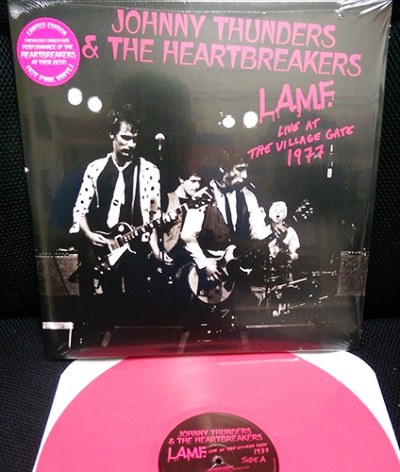 I worked on it some more, processing it with some equalization to bring out the instruments and adding some reverb and compression and doing some rough cuts on the crowd and in between song ambiance.
I worked on it some more, processing it with some equalization to bring out the instruments and adding some reverb and compression and doing some rough cuts on the crowd and in between song ambiance.
Jungle passed on it. Another small label was willing to put it out but there was no money offered. By now it was a few years later and Phyllis suggested I send a copy to Danny Garcia, who was making the “Looking for Johnny” documentary. He liked it but with all the licensing issues with the film he wasn’t able to use it. He suggested I contact Cleopatra Records in LA as they had put out some of Johnny’s stuff and might be interested.
I contacted their A&R guy, Matt Green and gave him a copy. They liked it right off and offered us a very good deal and were very supportive of the time it took for me to get everything done - and believe me, I drove them crazy at times! But we got it done and they put out a great package of the LP and CD.
I got together with Andy in NY and we did some more editing, mostly on the intro and the in-between song chatter, added some feedback and a few sound bites from the other nights. Actually we spent more time doing that to give it a good fast flow, than the songs themselves, although it is pretty close to the pace of the evening. There were a few minor glitches that we fixed, but nothing major. After that I took it in to Fantasy Studios in CA, and did some more editing and processing on the sound.
I had a basic concept for the photos and the liner notes and Cleopatra’s art department did the design and layout. I had always wanted to use Roy Trakin’s review of the shows in the New York Rocker because they so aptly described the show. Bob Gruen’s photos and the other classic shots from back stage by Ebet Roberts and Gary Green were key in the whole layout. Cleopatra did a great job on the packaging.
One a scale of 1-10, how do you rate these Heartbreakers shows?
I would give them a 9. There are a few other shows after that from Max’s that are very good too. A couple of those shows were video taped. I guess the Lyceum is up there too, but I favor the Gate and those Max’s shows.
Is there anything else in the archives from this run of gigs?
As I said before there is a audience recording posted on line and I have it, but the balance is not too good, as the taper was sitting in front of Johnny so Walter is a little buried in the mix. Who knows though I might give them a second listen and see if there is anything that can be used for Volume 2. I am also hoping to get some of the videos from Max’s released, but nothing is in place for that yet.
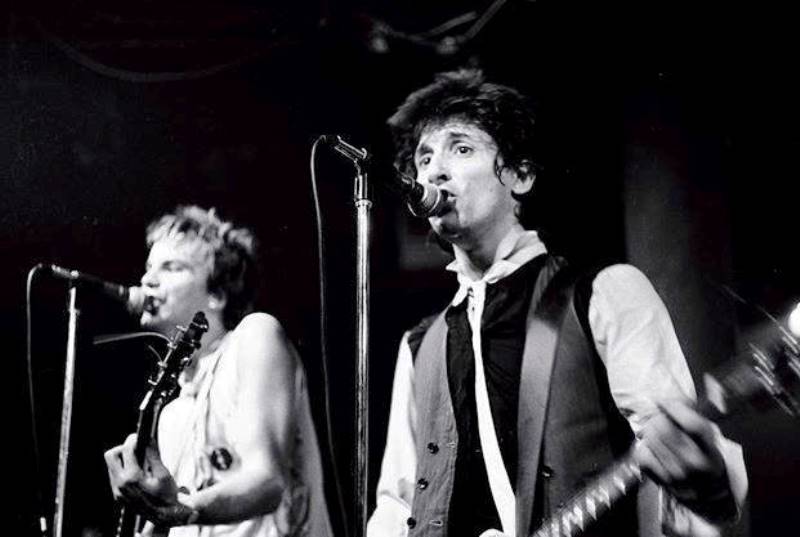 Walter Lure and Johnny Thunders at the Village Gate in 1977. Phyllis Stein photo
Walter Lure and Johnny Thunders at the Village Gate in 1977. Phyllis Stein photo
The Village Gate closed in the 1994 and re-opened as a live theatre space. Do you know if it’s still going?
It is now called Le Poisson Rouge and is live music and cabaret venue.
Was this the last time you’d cross paths professionally with Johnny Thunders and the Heartbreakers? Who else have you gone on to work with?
I continued on as their sound mixer for their shows at Max’s, through the “Live at Max’s” album. Billy was a big advocate for me doing their sound and I think Jerry liked the way I mixed the drums. I kind of have a ‘wall of sound’ approach to live mixing so giving John lots of reverb and cranking the guitars was a given. He and Walter were always vying for volume against each other. They even paid me, which for them is a feat in itself!! Walter and I were friends and hung out a lot together outside the gigs.
By then I was also working with Patti Smith, The Feelies, the B52’s, Richard Lloyd, Lester Bangs and a number of other bands. I do have some live recordings of both the Feelies and Patti that I hope might some day be released. There is a compilation of Ork Records that was recently put out by the Numero Group in Chicago and I have about eight or nine tracks on that.
I left NY in the late ‘80s (too much junkie business - LOL) and relocated to DC where I started working at Inner Ear Studios. I worked with John Stabb from Government Issue, some guys from Minor Threat and some other guys that came out of a band called the Crippled Pilgrims. I lean towards guitar oriented bands and like the more underground-unknown bands as I find they have a more spontaneous creativity.
You were something unusual back then as a female sound engineer. What was that like? Did you encounter any problems with the bands or people on the scene?
I was probably one of the first women to do sound engineering. I didn’t have much difficulty breaking in because the scene was so non-gender oriented. There were women in bands and playing instruments as well as fronting bands so everyone was pretty supportive of me. I gave everyone a distinctive sound based on what they needed individually to define their sound rather than one approach applied to all of them. I don’t usually play the gender card but to a certain degree I found that when bands got signed partly, because of demo’s or shows that I had done with them, I would then be overlooked in favor of male engineers or producers.
 What would your advice be to other women wanting to make a mark in (what's left of) the music industry today?
What would your advice be to other women wanting to make a mark in (what's left of) the music industry today?
That’s tough one. I started out because I had a boyfriend in a band and I just starting recording them. I think I had a gift for it and it came pretty easy for me. I guess the best advice I could give is to be confident in yourself and develop your own style and approach and don’t let the guys intimidate you. Unfortunately now, with all the DIY records coming out, producers and engineers are a lost breed and the records coming out are average at best. Also don’t believe the hype of all the recordings schools. While they are good for basic training it is really best to just get out there and learn it in the field.
Who were your favorite bands to work with back in NYC and why?
I would say the Feelies were my favorite and I worked with them for three years up through Crazy Rhythms. The Heartbreakers of course, along with Patti Smith, and Richard Lloyd. I liked guitar oriented bands and these were some of the best. The B52’s were fun and I turned Blondie down! Big mistake lol!
How did you get to work with Richard Lloyd after Television and what was that like? Was this around the time of "Alchemy"? I could never work out why he didn't break in a big way...
I had seen Richard in Television but I didn’t really meet him until Terry brought me in to work on a single that Richard was doing for Ork. After that we became friends and I worked on a song he had given to Chris Stamey to record for Ork, as well as a version of it of his. When Television broke up I started mixing sound for him.
Vinny DeNunzio had left the Feelies and joined up with him and I recommended a kid I knew as a second guitar. This was during the period leading up to the recording of “Alchemy”. Since he was signed to Electra when the sessions for “Alchemy” began they brought in their own producer and another guitarist. The producer was very set on doing some rearranging of the material and the result was what you got on “Alchemy”. The original arrangements of the songs on “Alchemy” were more straight ahead rockers that I personally thought were better. He never really got the promotion from the labels as well as dealing with his own personal demons.
What are your memories of Terry Ork? You must have been stoked to see that box set of Ork Records recordings come out.
Terry was a totally loveable, jovial and brilliant person. He saw the genius in everyone and had it not been for him things might have never turned out they way they did. He had the vision that there was going to be a musical revolution and he in large part made it happen. He is the first person use the phrase New Wave which is derived from French term nouvea for new, and that came from his love of French film noir. He saw that in the stark images of Verlaine and Hell. He also dubbed some of the 2nd wave of off beat bands as No Wave. Others have taken credit for those terms but they came from Terry. Terry made it all happen!
I was fairly involved in the Ork box set. I had always hoped that some day his recordings would be reissued so it was a dream come true when Numero contacted me about it. I had the recordings of the Feelies that had never been released and I had hung on to for 30 plus years. I also had some other recordings that I had done with them that had never been heard. I was an associate producer on the it and helped them get in touch with some of the other artists and gave them a lot of images and flyers and posters and connected them with David Godlis who had many of the great photos of everyone including the one here of me and Terry.
Since we’re in a bar, what are you drinking?
Well I wasn’t drinking too much in those days since I favored other intoxicants, but in general Heinekens at CB’s and Black Russians at Max’s. Now non-alcholic beers and tonic water, straight, no chaser! LOL!
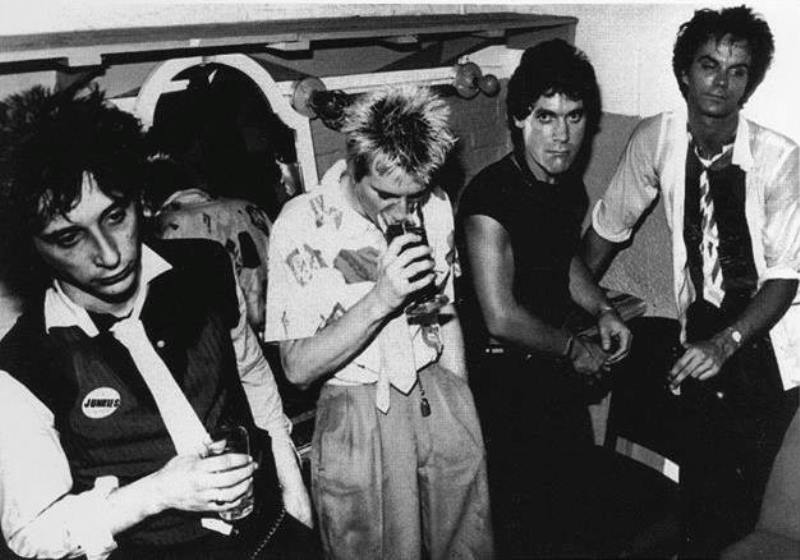
Backstage rider at The Village Gate. Don't worry, be happy! Phyllis Stein photo


